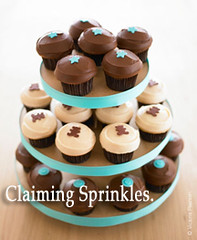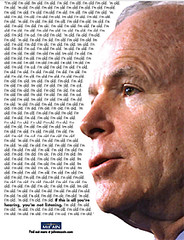The next time your read a recipe that calls for sprinkles on top of a cupcake, it might be a recipe for disaster. At least that’s what the legal eagles charged with defending the name of a three-year-old “cupcake only” shop in Beverly Hills thinks.
According to the Los Angeles Times, Sprinkles has sent about a dozen letters to shops around the country and filed three lawsuits, including one last month against Famous Cupcakes in North Hollywood because it too uses dots on its packaging and in its store.
But what’s so odd about warning away other small businesses from using candy, dots, and other decorations is that Sprinkles doesn’t even use dots all that much in its identity or on its Web site. In fact, it seems to me that few, if any, of the cupcake bakeries have any similarity in their presentation. See for yourself: Sprinkles Cupcakes, Sprinkled Pink Cupcake Couture, and Famous Cupcakes.
Sure, I’m not an attorney, but I do know enough about trademarks to understand no one can claim common symbols or words like sprinkles. I also know my grandmother used to adorn her cupcakes with a candy corn at the end of every October and Necco Wafers whenever it struck her. She had taken the idea from a small neighborhood bakery in the Midwest.
So when you add it all up, whatever Sprinkles Cupcakes thinks it can gain from flirting with legal action against other bakeries will be lost to bad public relations. And it might become worse than that.
Beyond looking greedy or silly or petty or all of the above, these lawsuits could run the risk of the company having its own identity challenged. After all, Sprinkles Custom Cakes has held sprinkles.com since 1997. Since trademarks are based on first published usage, not first registration filed, sprinkles.com or any other bakery that has happened to use sprinkles in their name might do the same.
Conversely, if Sprinkles loses even one lawsuit, it’s likely more bakeries will be adding “sprinkles” to their names; not fewer as the owners of Sprinkles Cupcakes had hoped. It’s already on the radar. [Hat tip: Spin Thicket.]

According to the Los Angeles Times, Sprinkles has sent about a dozen letters to shops around the country and filed three lawsuits, including one last month against Famous Cupcakes in North Hollywood because it too uses dots on its packaging and in its store.
But what’s so odd about warning away other small businesses from using candy, dots, and other decorations is that Sprinkles doesn’t even use dots all that much in its identity or on its Web site. In fact, it seems to me that few, if any, of the cupcake bakeries have any similarity in their presentation. See for yourself: Sprinkles Cupcakes, Sprinkled Pink Cupcake Couture, and Famous Cupcakes.
Sure, I’m not an attorney, but I do know enough about trademarks to understand no one can claim common symbols or words like sprinkles. I also know my grandmother used to adorn her cupcakes with a candy corn at the end of every October and Necco Wafers whenever it struck her. She had taken the idea from a small neighborhood bakery in the Midwest.
So when you add it all up, whatever Sprinkles Cupcakes thinks it can gain from flirting with legal action against other bakeries will be lost to bad public relations. And it might become worse than that.
Beyond looking greedy or silly or petty or all of the above, these lawsuits could run the risk of the company having its own identity challenged. After all, Sprinkles Custom Cakes has held sprinkles.com since 1997. Since trademarks are based on first published usage, not first registration filed, sprinkles.com or any other bakery that has happened to use sprinkles in their name might do the same.
Conversely, if Sprinkles loses even one lawsuit, it’s likely more bakeries will be adding “sprinkles” to their names; not fewer as the owners of Sprinkles Cupcakes had hoped. It’s already on the radar. [Hat tip: Spin Thicket.]




















